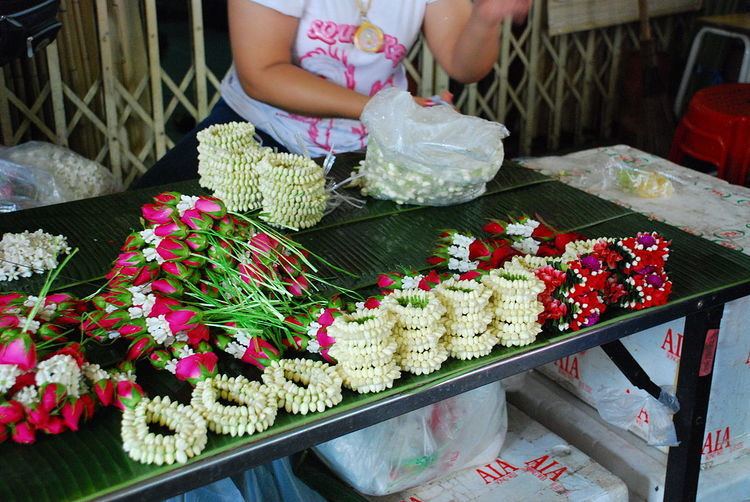 | ||
Phuang malai (พวงมาลัย) are a Thai form of floral garland. They are often given as offerings or kept for good luck.
Contents
Origins of phuang malai
There is no written evidence on who first created phuang malai. The first record of phuang malai was found during the reign of King Rama V or Phrabat Somdet Phra Paramintharamaha Chulalongkorn the Great. There was a literary work written by the king called "Royal ceremony in 12 months" พระราชพิธีสิบสองเดือน which contained information about events and ceremonies in the Sukhothai Kingdom. In the 4th month ceremony, it was mentioned that fresh flower garlands were made by the king's chief concubine “Tao Srijulalux” พระมหาเทวีศรีจุฬาลักษณ์. Then, in the Rattanakosin Kingdom the phuang malai became an important ornamental object in every ceremony. Every girl in the palace was expected to acquire the skills of making phuang malai. Queen Sripatcharindra สมเด็จพระศรีพัชรินทราบรมราชินีนาถ พระบรมราชชนนีพันปีหลวง devised a wide variety of intricate phuang malai patterns.
Patterns
Phuang malai patterns can be divided into six groups.
- Creature malai resembles animals. Flowers are arranged into animal shapes such as mouse, rabbit, squirrel, and gibbon.
- Chained malai is a series of rounded malais connected together which resemble a chain.
- Braided malai two rounded malais connected together, decorated with pine-shaped malai on each end.
- Vine malai is a series of semicircular malais arranged in a vine shape.
- Laced malai is a malai fully decorated by inserting golden and silver laces all over the malai both inside and out.
- Orchid malai is made only from orchids.
Uses
Phuang malai can be classified into three categories by use.
- Malai chai deaw มาลัยชายเดียว is usually used as an offering to show respect. In temples and cemeteries, these malais can be seen hanging from the hands of Buddhist monk statues along with votive candles. Chained malai and braided malai are examples of malai chai deaw.
- Malai song chai มาลัยสองชาย is usually draped around a person's neck to show importance. In the Thai wedding ceremony, both bride and groom often wear malai song chai.
- Malai chum rui มาลัยชำร่วย or souvenir malai, the smallest form of malai, is usually given as a souvenir to a large group of people. These malais are customarily given by a host, for instance, in wedding ceremonies, housewarming ceremonies, birthday parties, and baby showers. Creature malai is one form of malai chum rui. The purpose of malai chum rui is similar to that of lei (garland) in Hawaiian culture.
In addition to the malai's use as offerings, gifts, and souvenirs, malai have many more functions. They can be used to decorate throne halls and houses. Malai can also be hung on Thai musical instruments to pay respect to the masters of those instruments and for good luck and success in a performance.
Bamboo garlands
Thai bamboo garlands are decorative woven offerings sometimes used as a substitute for floral garlands and as a way to hang other offerings. Bamboo garlands are part of the tradition of Phoo Thi in the village of Kut Wa in Kuchinarai district, Kalasin province, in the northeast of Thailand. Bamboo garlands are also used in the festival of Buddhist Lent during the Thai rainy season, called “Bun Khaw Pra Dab Din” or “Bun Phaung Malai Baankutwa”.
Bamboo garland ceremony, Kut Wa, Thailand
To celebrate Phoo Thi, the villagers of Kut Wa create ornate garlands and form a procession around Kok temple to display their handiwork, with dancing, singing, and rhythmic drumming.
